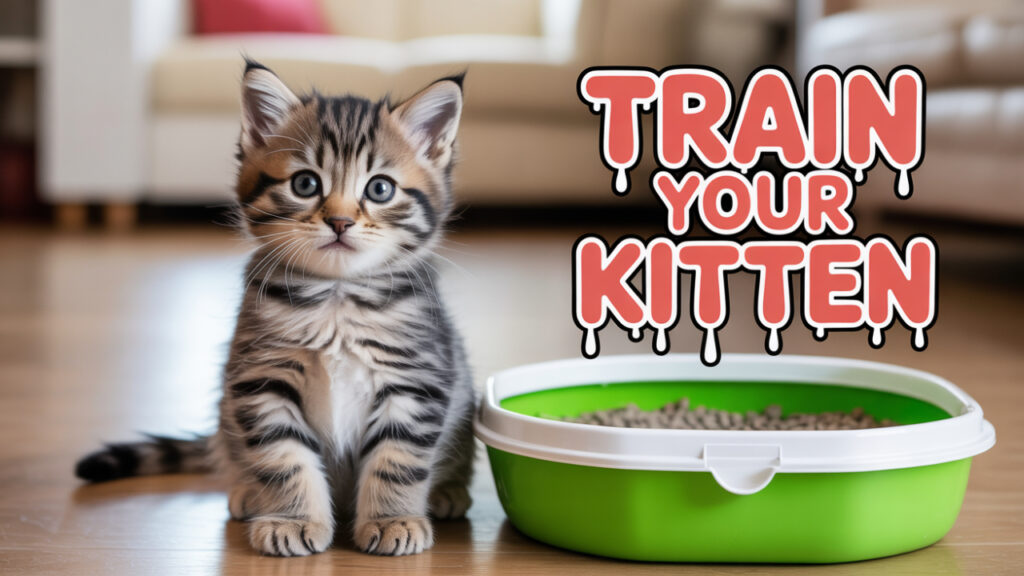Since kittens look out for a corner to pee, simply setting the box in a quiet, accessible location is an incentive to use it. Watch your kitten for indicators that they have to go, such as scratching or sniffing the ground, and immediately place them in the box during these times. Consistency is essential — clean the box often and treat your kitten when they use it appropriately. Eventually they will connect the box with going. This cultivates good habits and a clean environment for you and your furry friend.
Preparing for Success
Before you dive into litter training kittens, you first need to lay the groundwork for success. That is, making sure you have the right supplies for proper litter box habits. A checklist can help simplify the preparation.
- Litter Box: Choose a shallow uncovered box or tray, as most kittens prefer this style for ease of access. A good size is around 33x23cm, or 1.5 times your kitten’s length.
- Quantity: Provide enough litter boxes, ideally one for each cat plus one extra, to prevent territorial disputes.
- Location: Position boxes on every floor of your home and keep them away from other cats’ territories to reduce stress.
The Box
Choose a low-sided litter box for your petite kitten. This will allow them to get in and out without a fight. Plastic box or tray, which is preferred because of the ease of cleaning.
Trying out different styles wouldn’t hurt either, as some kittens have a particular preference for coziness. If you have a litter of kittens, multiple boxes will reduce box turf wars and promote usage.
The Litter
Fill the box with approximately 3 inches of fine, unscented litter. This provides depth for digging, which a lot of kittens love. Don’t use clumping litters until your kitten is about 4 months old because they may eat it as they explore.
Avoid chemically treated or perfumed litters that irritate. Experimenting with different natural litters to discover the one your kitten prefers will establish a favorable connection with the box.
The Location
Locate the litter box in a quiet place that your kitten can easily get to. Places your kitten frequents is a good lure to utilize. Provide privacy, critical for their comfort, by keeping the box away from high-traffic areas.
Don’t put the box near food and water dishes. If you have to relocate the box, do so incrementally, moving it a few feet this way and that each day to avoid mishaps.
how do you potty train a kitten
Kittens are naturally inclined to bury their business, making litter training a straightforward process. With a little direction, you can successfully train kittens to use a litter box.
1. The Introduction
Take your business kitty to the litter box the minute you get it home. This early exposure goes a long way toward developing familiarity and comfort with proper litter box habits. Use positive reinforcement to make the box a nice place to be; give them a treat or praise when they investigate. Let your kitten sniff around the box to acclimate to the area. Be patient, as many kittens can be slow to identify the box as their toilet.
2. The Cues
Watch your kitten for indications that it needs to go, like sniffing or circling. When you see these signs, place your kitten in the litter box. Set up a potty phrase to aid in litter training kittens. If you can spot trends in your kitten’s behavior when it’s box time, this will enable you to better predict when your young kitten might have to go, thus smoothing the process.
3. The Routine
It’s all about establishing a routine for training kittens. Feed him on a schedule to encourage regular bathroom habits. After meals or naps, escort your young kitten to the litter box, cementing the habit. Providing a stable, secure environment facilitates litter training success, helping your kitten develop proper litter box habits.
4. The Praise
If your new kitten appropriately uses the litter box, reward her immediately with praise and treats. A happy voice complements the good action and encourages your young kitten to repeat it. Avoid yelling at accidents, as this can teach fear and stall progress. Reward little victories to develop your kitten’s trust in her litter training journey.
Common Training Hurdles
There are indeed some hurdles in litter training kittens. Here are some common problems and troubleshooting tips for successful kitten litter box training.
- Watch out for litter box stress.
- Identify possible distractions that might divert your kitten from the box.
- Keep cool and be patient in debugging training.
Sudden Aversion
Kittens can prematurely ‘potty reject’ the litter box as evidenced by behaviors like box avoidance or fear. Exploring potential causes is a key step, as dirty litter or uncomfortable box positioning might be key offenders. If your litter is too clumpy or smells, your kitten might reject it.
As a solution, offer an alternative litter box, maybe one with lower sides. If your kitten has gotten scared, bring the box out gradually in a safe area to help them re-acclimate.
Accidents Elsewhere
Mistakes will occur, but they can be handled. Here are some tips to handle them:
- Clean the area thoroughly to remove any lingering odors.
- If your kitten keeps dirtying a certain spot, move the box there.
- Watch your kitten’s habits to determine what is causing the accidents.
- Reward the good behavior by praising your kitten for his proper use of the box.
Knowing why these disasters happen can assist you in modifying your training. Kittens are naturally inclined to bury their waste, so if they’re shying away from the box, there could be a problem.
Box Behavior
See how your kitten reacts to the box. Watch out for digging and scratching – some kittens just won’t be lured into the box. Make certain the box is not too deep or high, which might dissuade use.
If your kitten appears reluctant, try moving the box to a different location – it can help. Multi-litter box options situated in easy-access locations are helpful in conquering training hurdles.
Kittens tend to train themselves, but if you begin this process at around four weeks, you’ll have better luck.
The Psychology of Cleanliness
The psychology behind cleanliness is key when litter training kittens. Kittens innately enjoy living in a clean environment, which influences their litter box behavior. If a kitten’s litter box is dirty, it won’t use it, highlighting the importance of maintaining a clean litter box to cultivate positive habits for successful litter training.
Your Kitten’s Perspective
Kittens think the world revolves around them. They are smell and texture oriented, so the cleaner the litter box, the more eager they are to use it. If the litter box is stinky or dirty, a kitten will shun it altogether. The best way to encourage your kitten to be well-behaved is to offer a clean, nice box.
Follow your kitten’s lead on litter selection and box design. Certain kittens will want a covered box, others an open box. By paying attention to their tendencies, you can make the training experience more in tune with their instincts and sense of comfort.
A Cleaning Schedule
- Daily Maintenance: Scoop out waste daily. This avoids smells and keeps the box welcome. Once you’ve scooped, sprinkle fresh litter where necessary.
- Weekly Deep Clean: Deep clean the litter box weekly. Dump it out, soap & water the box & dry it before you dump in new litter. That gets rid of any residual stench and bacteria.
- Monitor the Environment: Keep track of your cleaning schedule. Let a calendar or an app remind you to clean the box.
- Adapt as Needed: Be prepared to adjust your cleaning routine based on your kitten’s behavior. If you catch your kitten shunning the box, it’s probably time to clean it more often.
Beyond the Basics
Training a kitten, especially in multiple cat homes, can be more subtle, but understanding proper litter box habits and using positive reinforcement can make your litter training success much sweeter.
Multi-Cat Homes
| Strategy | Description |
| Number of Boxes | Ideally, have one litter box per cat, plus one extra. |
| Box Location | Place boxes in different areas, away from food and water. |
| Cleanliness | Regularly clean each box to prevent odors and encourage use. |
| Monitoring Interactions | Observe how cats interact around the boxes to identify any issues. |
If you have a multi-cat home, this is especially important – each cat should have access to its own litterbox. This avoids territorial issues that can occur when several cats contend for one box. Thoughtful placement of each box can help—put them in quiet, low-traffic areas to provide each cat with a feeling of security and seclusion.
You want to keep the boxes neat and tidy. Frequent scooping not only minimizes smell but motivates all your cats to use them. Observe cats’ interactions — if you catch one cat bullying another near the litter box, it can influence them to avoid using it.
Travel Training
Getting your kitten acquainted with a portable litter box will be crucial for travel. Before you travel, get your kitten used to this travel box at home. You can throw treats or toys in to associate the place with positive experiences.
When on the road, reward your kitten for using the box. Praise and rewards can help entrench this behavior. For longer trips, schedule in stops so your kitten can go potty. This not only prevents mishaps but ensures your kitten’s comfort.
Health Indicators
| Health Indicator | Possible Concern |
| Reluctance to Use the Box | May indicate discomfort or health issues. |
| Changes in Urination Frequency | Could signal a urinary tract infection or dietary problems. |
| Diarrhea or Straining | Often requires immediate veterinary attention for underlying issues. |
Keeping an eye on your kitten’s health is part of the litter box training process. If your kitten is having trouble or refusing to use the box, then it’s best to take them to the vet. Watch out for any change in diet, as it can affect bathroom behavior greatly.
Symptoms such as diarrhea or straining require medical assistance. Noticing these signs helps you to nip health issues in the bud.
Decoding Your Kitten’s Instincts
Kittens typically feel a natural urge to pee in certain places. Understanding your kitten’s instincts can help uncover these predispositions and is essential for effective litter training. For example, if your kitten begins to sniff or scratch at the floor, it’s searching for somewhere to go. Recognizing these signs can guide you in training accordingly and facilitate a smoother kitten litter box training journey.
Kitty substrate preferences play a significant role in litter training success. Some kittens may favor sand-like fine-grained litter, while others might prefer larger granule varieties. The litter’s texture and scent can greatly impact a kitten’s willingness to use the box. Experimenting with different litter types can help you discover what your kitten likes best, enhancing the overall training experience.
Pay attention to your kitten’s quirks and tailor the training experience to their needs. For instance, if your young kitten is utilizing a corner or section of your home, placing the litter box nearby can promote this behavior. Observing their habits after meals or playtime can also be beneficial, as these activities often activate the urge to go. By aligning your training with your kitten’s natural cycles, you’ll create a more effective potty training process.
Designing your environment is key to ensuring proper litter box habits. Place the litter box in a calm, convenient spot, away from interference. Cats prefer privacy when they go to the bathroom, so a secluded area will help your kitten feel secure. Additionally, cleaning the litter box consistently is crucial; a dirty litter box will deter your kitten. Using positive reinforcement, such as treats or praise when they use the box, will encourage good behavior and contribute to your kitten’s successful litter training.
Conclusion
It takes time and patience to potty train a kitten, but it’s a simple process. Begin by creating a location, and deploy the proper equipment. Identify your kitten’s instincts to direct your training. Handle any obstacles gently, but be consistent. Knowing your kitten’s natural instincts helps make for a smooth transition. With proper training, your kitten will get the litter box habit fast.
It’s worth the effort spent on this training. You create a sanitary atmosphere and your kitten is safe and cozy. Savor the experience, and cherish the unique connection you forge through this process. Begin now, and witness your kitten flourish in their new habit.
Frequently Asked Questions
How long does it take to potty train a kitten?
With a regular schedule and positive reinforcement, you can accelerate the litter training kittens process, achieving potty training success in just a few weeks.
What type of litter should I use for my kitten?
Choose a non-toxic, low-dust kitten litter that’s easy on your young kitten’s paws, as clumping litter is best for proper litter box habits.
How often should I take my kitten to the litter box?
After meals, playtime, and naps, bring your young kitten to the litter box to establish proper litter box habits and encourage good behavior.
What if my kitten refuses to use the litter box?
If your young kitten outright refuses to use the litter box, have her checked for health issues or preferences for different litter types. Ensure the box is clean and readily available.
Should I reward my kitten for using the litter box?
Yes, by using positive reinforcement and rewarding your kitten with treats or praise after using the litter box, you reinforce good litter habits.
Can I train an older kitten the same way?
Yup, same for older kittens; they might be slower to adapt during their litter training journey, but time and persistence are essential.
What are signs that my kitten needs to go?
Typical indicators are sniffing, circling, or meowing around the litter box, which are common signs during the litter training kittens process.





